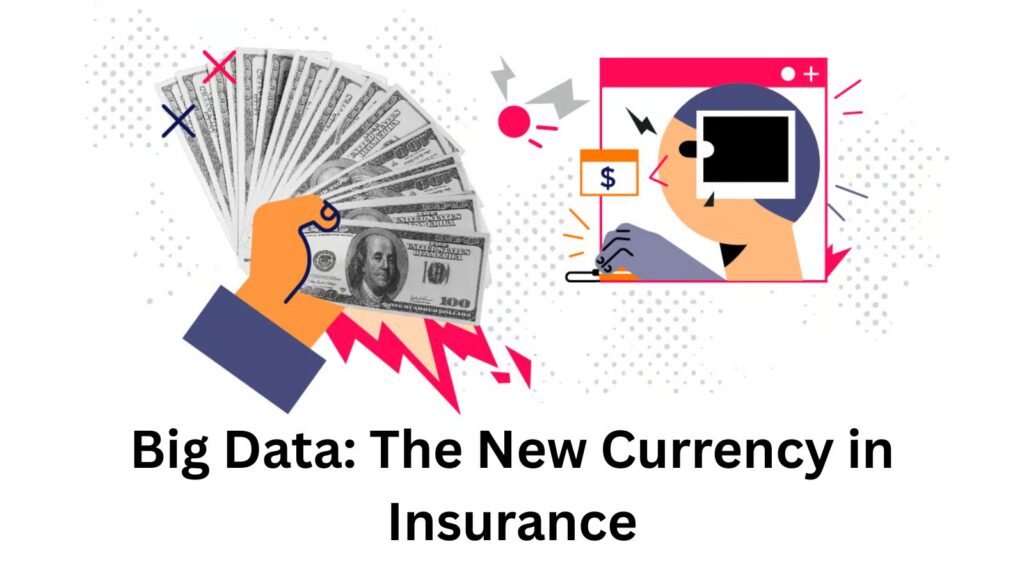In today’s digital world, data is the new currency, and the insurance industry is no exception. Big data is now a key asset for insurers. It helps them understand customer behavior, predict risks, and provide personalized services. Insurance companies can gather data from various sources. These include social media, telematics devices, wearables, and weather patterns. This helps them turn raw information into useful insights.

In the past, underwriting and pricing insurance policies were based on broad risk categories such as age, gender, and location. Now, with big data, insurers can understand each customer better. This helps them offer more accurate, fair, and personalized policies. This improves the customer experience and boosts efficiency for insurers.
Big data is transforming how insurers handle their policies. They use driving data to track risk factors. Also, wearable fitness trackers help assess health risks. Predictive analytics is key for better claims management and spotting fraud. Big data is changing the insurance world. It has real-time uses that impact both insurers and customers. Let’s explore these changes.
What is Big Data in Insurance?
Contents
- 0.1 What is Big Data in Insurance?
- 0.2 How Big Data Helps Insurers Understand Customer Behavior
- 0.3 Predictive Analytics: Improving Claims Management and Fraud Detection
- 0.4 The Future of Big Data in Insurance: What’s Next?
- 0.5 Conclusion: Big Data as the New Currency in Insurance
- 1 Frequently Asked Questions
- 1.1 How does big data help insurance companies understand customer behavior?
- 1.2 What is telematics, and how is it used in auto insurance?
- 1.3 How do wearable devices impact health insurance pricing?
- 1.4 What is predictive analytics, and how does it improve claims management?
- 1.5 How does big data help prevent fraud in insurance?
Big data means large and complex datasets. Regular data-processing software can’t handle them well. In the insurance industry, big data is collected from numerous sources, including:
- Telematics (Vehicle data): This is data from connected vehicles or smart devices. It tracks driving behaviors like speed, braking, and route.
- Wearables (Health data): These are devices such as fitness trackers and smartwatches. They track health metrics, including steps, heart rate, and sleep patterns.
- Social Media and Public Records: Learn from online activities and public records. This includes public health data and property history.
- Internet of Things (IoT): Smart home devices like security cameras, thermostats, and smoke detectors provide real-time updates on home safety and risks.
- Environmental Data: Weather patterns and natural disaster data assess property damage risk. This is crucial for areas prone to floods, hurricanes, or earthquakes.
Big data helps insurers predict future risks. It also improves pricing models and personalizes policies. This is based on individual behaviors and situations.
How Big Data Helps Insurers Understand Customer Behavior
Insurance companies used to gather only basic information to set premiums. They focused on general details like age, gender, and occupation. Now, big data enables a much deeper understanding of customer behavior by tracking various real-time data points. This info helps insurers see the physical risks. It also shows the lifestyle, preferences, and habits of policyholders.
Example 1: Telematics and Driving Behavior
One of the most significant uses of big data in the insurance industry is in telematics. Telematics is in-car tech that collects data on how you drive. It tracks things like speed, braking patterns, distance, and the time of day. This helps insurers judge risk better. They can then offer tailored pricing based on how a person drives.
Progressive Insurance has a program called Snapshot. It uses a telematics device that plugs into a car’s onboard diagnostic system. This device tracks driving habits. Safe drivers—those who drive less frequently or maintain safer speeds—receive discounts on their premiums. This program has made insurance cheaper for careful drivers. It also encourages safer driving.
Real-Time Example: Metromile is an insurer that provides pay-per-mile auto insurance. It uses telematics to track how many miles a driver drives. This allows low-mileage drivers to pay much lower premiums than traditional models would suggest, as their risk is lower. By using telematics, Metromile is able to create a more accurate risk profile for each driver.
Example 2: Wearable Devices and Health Insurance
Wearable devices, like fitness trackers (Fitbit, Apple Watch) and smartwatches, offer fresh chances for insurers. These devices collect data on an individual’s physical activity, sleep patterns, heart rate, and other health metrics. Insurers use this information to assess the health risks of a policyholder and adjust premiums accordingly.
Vitality, a global insurance company, rewards customers who lead healthy lives. Vitality tracks the policyholder’s physical activities through their app. This includes activities like walking, running, and cycling. Based on this data, they offer premium discounts and rewards for those who maintain healthy lifestyles. The more steps you take or the more exercise you engage in, the better your health profile, resulting in lower premiums.
This gives a financial boost for healthy living. It also lets insurers create personalized policies. These policies reflect a person’s real health instead of just general risk factors.
Predictive Analytics: Improving Claims Management and Fraud Detection
A big benefit of big data in insurance is using predictive analytics. This helps forecast risks, manage claims better, and spot fraud. Predictive analytics uses past data and stats to forecast future events and behaviors. In insurance, this means using data to expect what customers need. It helps improve underwriting accuracy and makes claims processes smoother.
Predicting Claims and Reducing Operational Costs
One of the key areas where predictive analytics is being applied is in improving claims management. Insurers can look at past claims data to see which ones may be big or complicated. This helps them use their resources wisely. Predictive analytics helps insurers spot high-risk claims. It shows them how to manage these claims better.
Allianz uses machine learning to look at claim data. It predicts how serious a claim might be by studying past trends. This helps the company use the right resources for claims. It also improves settlement predictions. As a result, claims get processed faster.
Fraud Detection Using Big Data
Fraud is one of the biggest problems facing the insurance industry, costing insurers billions of dollars each year. Big data and predictive analytics help insurers spot fraud. They do this by examining claims data for patterns and marking suspicious activities.
Insurers like AXA use predictive analytics. They analyze claims history, social media activity, and third-party data. This helps them spot potential fraud. This involves spotting inconsistencies in claim details. For example, check for mismatched accident reports. Also, look for differences between an insured party’s history and the claim events.
Insurers can use big data to spot fraud better. This helps them stop fraudulent claims before they lead to big financial losses. This not only protects insurers but also ensures fairer premiums for honest customers.
The Future of Big Data in Insurance: What’s Next?
As the amount of data continues to grow exponentially, so too will the opportunities for insurers to harness its potential. The next frontier of big data in insurance lies in the continued integration of new technologies, including:
- AI-Driven Personalization: The latest AI can help insurers understand what customers need. It allows them to tailor policies for everyone. AI can use real-time data from wearables and telematics. This helps adjust premiums. It can also suggest useful add-ons or policy changes based on a customer’s lifestyle.
- Blockchain for Data Security and Transparency: As big data grows in importance, secure storage and clear access to data are vital. Blockchain’s decentralized ledger protects data from cyber threats. It also ensures claims and policies are managed transparently.
- Real-Time Risk Assessment: The future of big data may include even more instantaneous risk assessments. For example, in auto insurance, insurers can assess risk in real-time. They look at a driver’s behavior, road conditions, and other factors. This allows them to create more dynamic pricing models.
Conclusion: Big Data as the New Currency in Insurance
Big data is changing the insurance industry. It helps insurers understand customer behavior, predict risks, and boost efficiency. Insurers can use telematics, wearable devices, and predictive analytics. These technologies help them provide personalized coverage. They also lower operational costs and reduce fraud.
As the industry continues to evolve, big data will play an even more crucial role in driving innovation. Insurers can enhance customer experience and stay competitive by embracing these data-driven advancements.
What is InsurTech? How Technology is Transforming the Insurance Industry
Frequently Asked Questions
How does big data help insurance companies understand customer behavior?
Big data helps insurers collect detailed insights from many sources. These include telematics, wearables, and social media. With this information, they can create better profiles of each customer’s needs and behaviors.
What is telematics, and how is it used in auto insurance?
Telematics involves using connected devices to collect data about a vehicle’s usage, such as driving speed and distance. Insurers use this data to personalize premiums, rewarding safe drivers with lower rates.
How do wearable devices impact health insurance pricing?
Wearables like fitness trackers allow insurers to monitor health metrics such as exercise and heart rate. By incentivizing healthy behavior, insurers can adjust premiums based on individual health profiles.
What is predictive analytics, and how does it improve claims management?
Predictive analytics uses historical data to forecast future outcomes. In insurance, this helps predict the cost of claims, detect fraud, and allocate resources more effectively.
How does big data help prevent fraud in insurance?
Big data helps insurers find patterns in claims data. By checking this data against other sources, they spot inconsistencies. This way, they can flag claims that might be fraudulent for further investigation.
Big data is the future of insurance. It gives insurers and consumers better, personalized, and efficient services. As the industry continues to evolve, the power of big data will only grow, making insurance smarter and more customer-centric.


